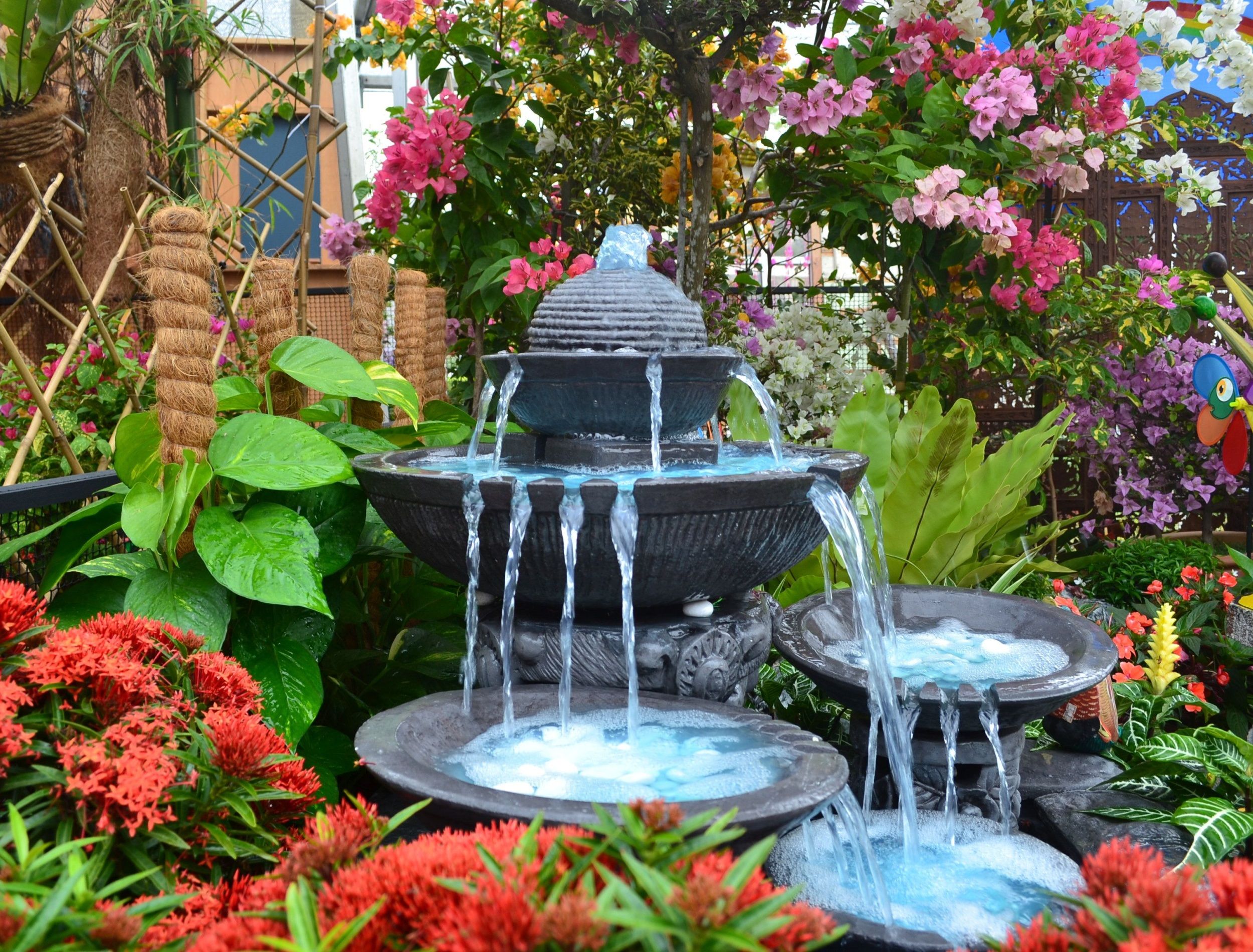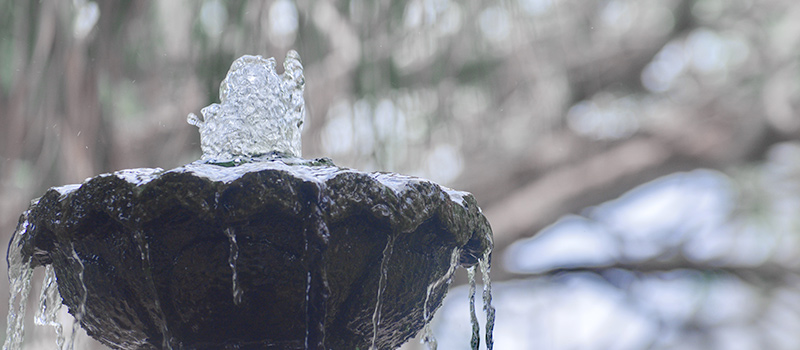An outdoor water fountain adds serenity and style to your outdoor available space during the warmer months. However, this is only possible if you know how to properly bring the fountain out of hibernation. As the harsh winter transitions into the gentle warmth of spring, it's time to give your fountain the care it deserves to bring it back to life. Here are five ways to prepare your outdoor water fountain for spring and ensure it's just as beautiful as it was last year.

Clean the Outdoor Fountain Basin
The basin is the foundation for your water fountain. Over winter, debris and algae can accumulate, leading to clogged pumps and unsightly residue. To clean the basin, ensure the fountain is off and remove any decorative items or pebbles. Then, gently scrub the basin with a brush and specially formulated fountain cleaner. Rinse thoroughly and replace the decorative elements once the basin is clean. Regular cleaning is an excellent practice throughout the year to maintain your fountain's appearance and functionality.
Step-by-Step Cleaning Process
-
Turn Off the Fountain & Remove Decorative Elements
Before beginning any cleaning, ensure the fountain is powered off and unplugged to prevent any electrical hazards. After that, carefully take out any stones, pebbles, or decorative items from the basin. This allows for a thorough cleaning and prevents damage to these elements. -
Drain the Water & Scrub the Basin
Empty the basin completely to access all surfaces. If your fountain lacks a drain plug, use a siphon or scoop to remove the water.
Using a soft-bristled brush and a solution of mild dish soap and warm water, gently scrub the interior surfaces of the basin. Pay special attention to areas with visible algae or mineral buildup. -
Tackle Stubborn Stains
For persistent stains or mineral deposits, create a mixture of equal parts white vinegar and water. Apply this solution to the affected areas and let it sit for 15–20 minutes or one hour. Then, scrub with the brush to remove the buildup. -
Rinse Thoroughly & Dry the Basin
After cleaning, rinse the basin thoroughly with clean water to remove any soap or vinegar residue. This step is crucial to prevent any chemical residues from affecting the water quality. Then, allow the basin to air dry completely before refilling it with water. This helps prevent the growth of mold or mildew. Once the basin is dry, replace the decorative elements and prepare the fountain for refilling.
Check and Clean the Pump
You also need to devote some time to the fountain's pump. The pump is the heart of your outdoor water fountain, and ensuring it's clean and working properly is crucial. Otherwise, you risk the pump overheating and experiencing damage. By following these steps, you can ensure that your fountain pump remains in excellent working condition, providing a peaceful atmosphere in your outdoor space.

Disconnect the power to the pump, then remove and clean it by rinsing it with a gentle stream of water to dislodge any debris or dirt. Use a soft brush or cloth to remove debris, algae, and mineral deposits from the parts. For stubborn buildup, soak the components in a mixture of white vinegar and water (50/50) for 15–20 minutes, then scrub gently.
After cleaning, inspect for any signs of wear, such as cracks or loose parts. Look at the cord for any damage and plug it in to verify it's still working correctly.
Inspect and Repair Cracks or Leaks
Cracks in the fountain not only detract from its aesthetic but can also lead to water loss and damage to the structure. Because of this, it's vital that you thoroughly examine the fountain for any visible cracks.
Begin by carefully examining the entire fountain, including the basin, tiers, and surrounding areas, for any visible cracks or signs of water leakage. Pay close attention to areas where water may pool or seep out. For a more precise detection, you can perform a water test by filling the fountain and observing any drops in water level over time. For minor cracks, you can use a waterproof sealant or epoxy designed for outdoor use.
For more significant cracks or structural damage, it's advisable to consult a professional. They can assess the extent of the damage and recommend appropriate solutions, such as reinforcing the structure or replacing damaged components. Attempting to repair substantial damage without proper expertise may lead to further issues.
Trim Surrounding Vegetation
Another effective way to prepare your outdoor water fountain for spring is to cut away any foliage blocking it from view. Overgrowth of plants around your fountain can lead to debris falling into the water and roots potentially causing damage. With the arrival of spring, plants begin to flourish, so it's a good time to evaluate the area around your fountain. Also, trim branches or overhanging plants that could shed leaves into the fountain.

Benefits of Trimming Vegetation
Enhanced Aesthetics: Properly maintained plants and shrubs frame your fountain beautifully, enhancing its visual appeal.
Improved Water Quality: Removing decaying leaves and organic matter reduces the risk of algae growth and maintains clear water.
Optimal Pump Function: Trimming back roots and overhanging branches prevents potential damage to the pump and ensures efficient water circulation.
Maintenance Tips
Regular Pruning: Schedule routine trimming to prevent overgrowth and maintain a tidy appearance.
Selective Planting: Choose plants that complement your fountain's design and don't obstruct water flow.
Mulching: Apply mulch around the base to suppress weeds and retain soil moisture.
Test and Adjust Water Flow
The flow of water is critical for creating a pleasing aesthetic and for aeration, which helps prevent stagnation. Turn on the fountain and observe how it runs. The ideal flow should create a gentle ripple without excessive splashing or water loss. Adjust the flow using the fountain's controls if necessary. If the flow seems weaker than before, it could indicate a problem with the pump or clogging, and you may need to check for damage or blockages.
Steps to Test and Adjust Water Flow
-
Turn on the Fountain: Activate the pump and observe the water flow.
-
Assess the Flow: Ensure the water creates a gentle ripple without excessive splashing or water loss.
-
Adjust the Flow: Use the fountain's controls to modify the water flow to your desired level.
-
Check for Issues: If the flow seems weaker than before, inspect the pump for clogs or damage.
-
Consult a Professional: If problems persist, consider contacting a specialist to inspect and repair the fountain.
Add: Key Tips for an Outdoor Fountain for Winter
To maintain the beauty and functionality of your outdoor water fountain, proper winter preparation is crucial. Protecting it from freezing temperatures and winter elements will ensure that it’s ready to flow again once the weather warms up. Here's what you need to do:

Drain the Water features
Before the first frost, make sure to drain all the water from your fountain. Leftover water can freeze and cause damage to pipes and pumps. Emptying it will protect against expansion and cracking, ensuring that your outdoor water fountain continues to deliver soothing sounds for years to come.
Clean and Inspect
Take the time to clean your fountain thoroughly before storing it for the winter. Use a non-abrasive cleaner to remove algae or mineral buildup. Inspect the pump, pipes, and any LED lights to make sure everything is in good condition. It's also a good time to check the fountain for any potential repairs you may need.
Cover or Store the Outdoor Fountain
If possible, store the fountain in a dry, sheltered place like your garage or shed. If not, use a high-quality cover designed for outdoor water fountains. A good cover will keep snow, ice, and debris out while allowing the fountain to breathe. This will help preserve the durability of the material, whether it's rock, natural stone, or metal.
Protect the Pump
For larger fountains, you may need to remove the pump and store it indoors. Freezing temperatures can cause pumps to crack or freeze. If storing indoors is not possible, make sure to wrap the pump in weatherproof material and place it in a secure spot.
Protecting the Landscape
The landscape around your fountain is just as important as the feature itself. Ensure that the ground around your outdoor fountain, whether on your patio, in your garden, or backyard, is clear of fallen leaves and debris. This will not only keep the area looking neat but also prevent algae buildup when water starts flowing again.
Conclusion
With these simple maintenance steps, you're sure to enjoy a picturesque and functioning water feature throughout the spring and beyond. LuxenHome's series of outdoor waterfall fountains are the perfect complement to any home, garden, or commercial setting, creating a calm and peaceful atmosphere that anyone can enjoy. Reach out to us today to learn more about your options and how to keep these beautiful pieces in top shape.
FAQs about Garden Fountains for Spring
Q1. What is the best way to store my outdoor fountain during winter?
A: To protect your outdoor water fountain, it's best to either store it indoors or cover it with a high-quality weatherproof cover. If it’s too large to store, make sure it’s cleaned, drained, and covered well to prevent any weather-related damage.
Q2. Can I leave my fountain outside during the winter?
A: While it's generally better to store your fountain indoors, if you must leave it outside, ensure it's properly drained and covered. The risk of freezing and cracking can cause significant damage if not addressed.
Q3. How do I restart my outdoor fountain after winter?
A: When spring arrives, clean out any debris, check the pump and pipes, refill the fountain with clean water, and make sure the water flows freely. Adding natural elements like stones, plants, or LED lights can help revive the peaceful atmosphere of your outdoor space.

Leave a comment